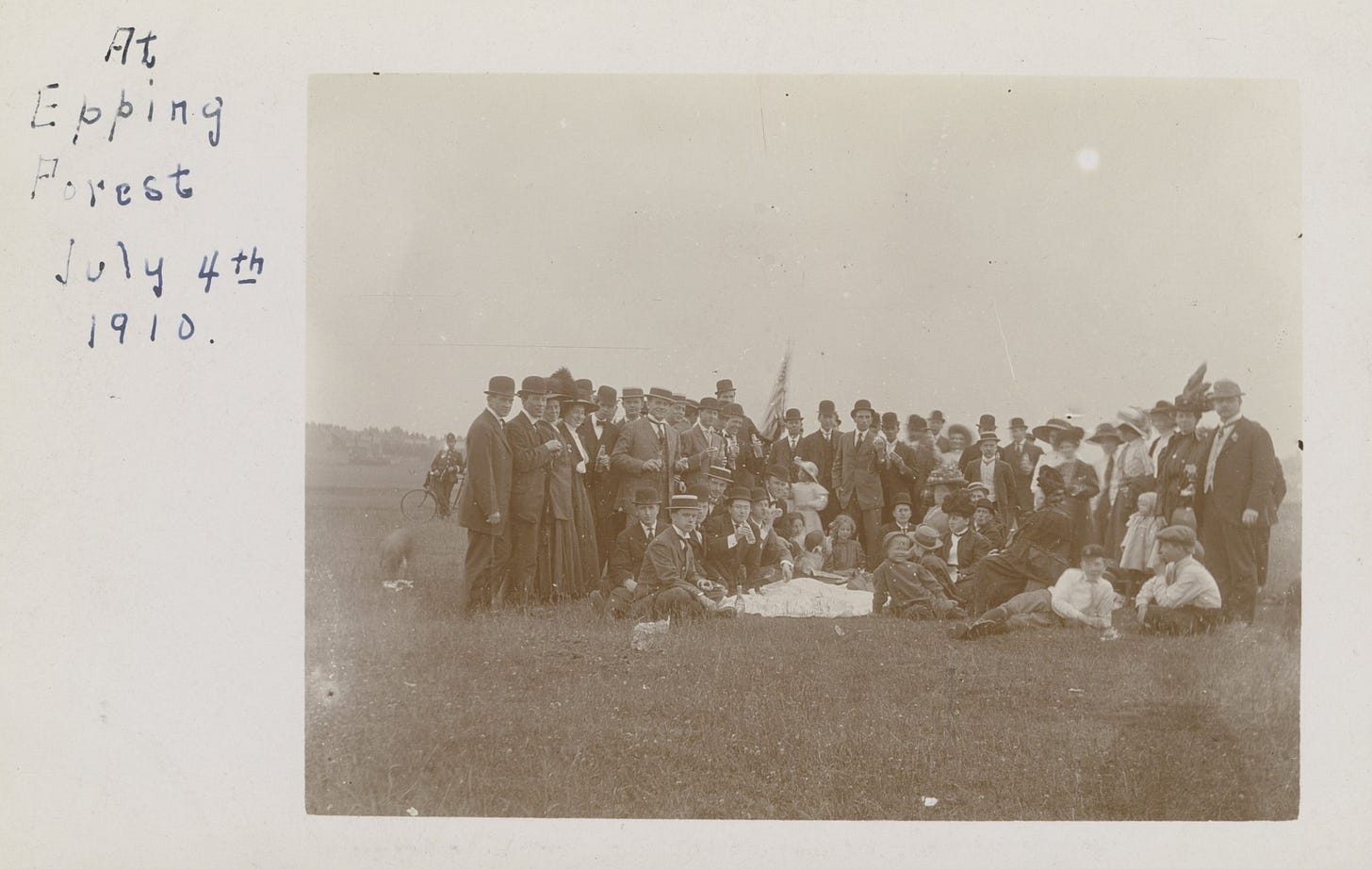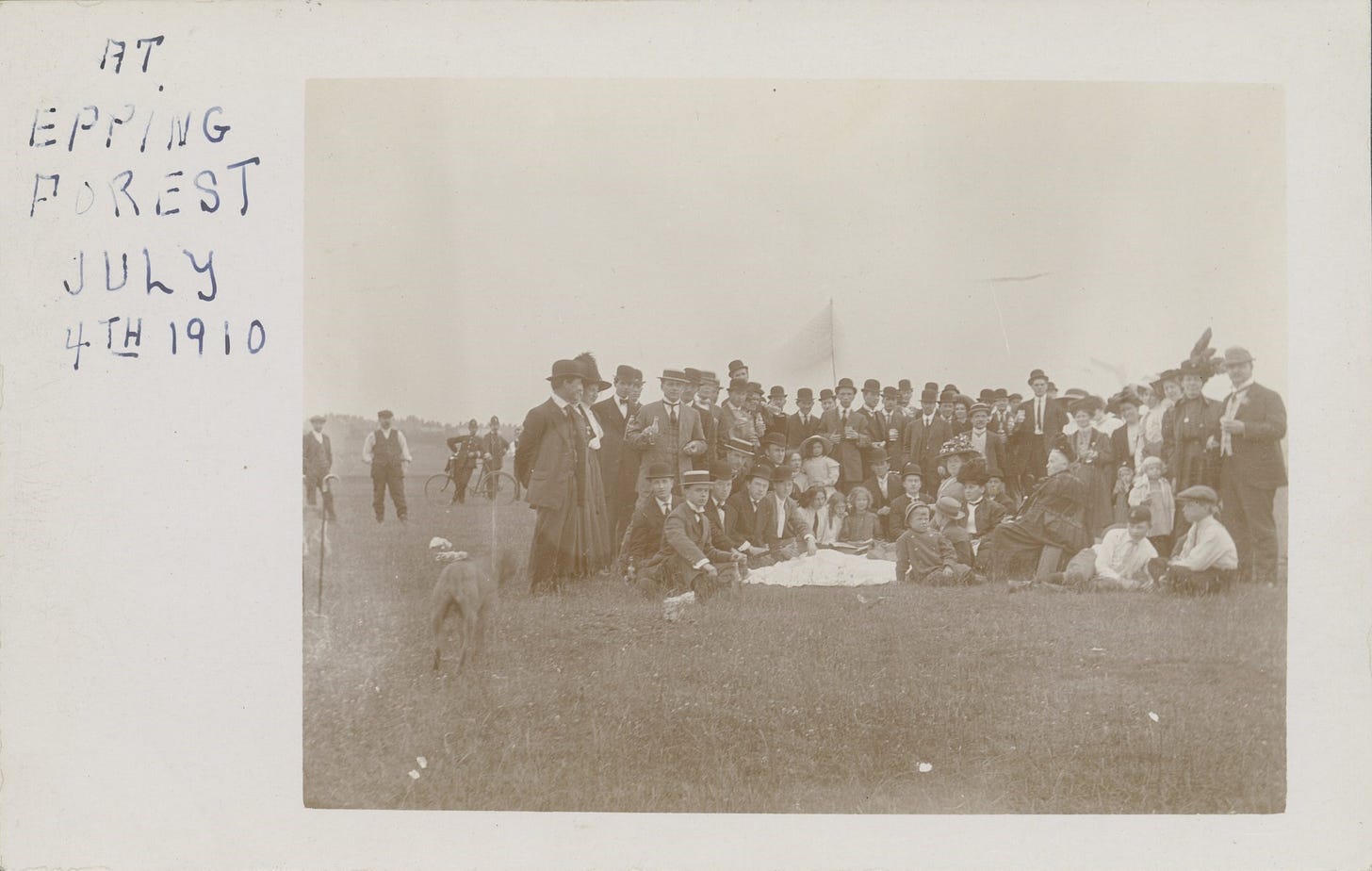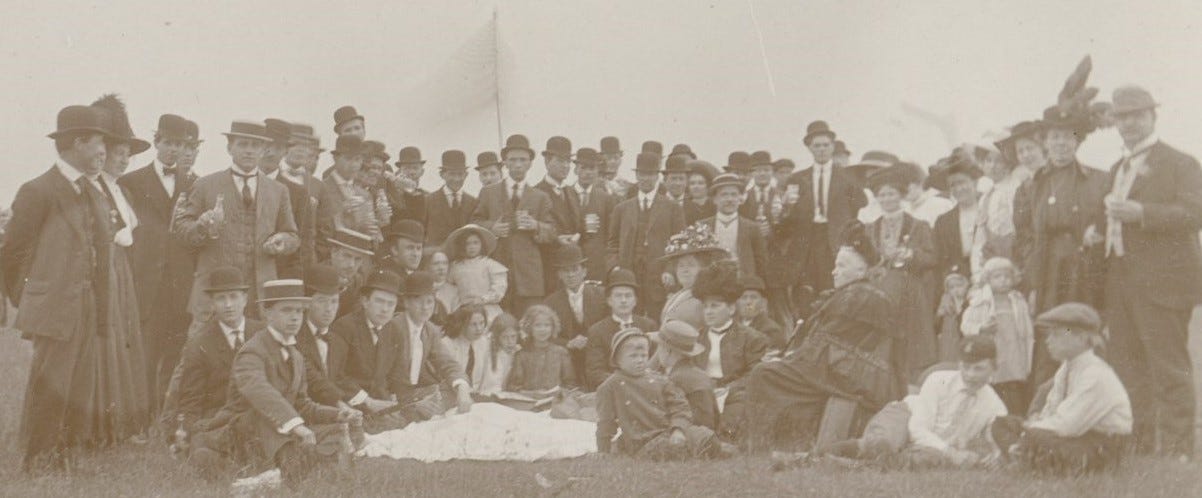What's in the bottles?
Uncovering an Edwardian outing to Epping Forest on 4th July 1910
Epping Forest has been a popular site with Londoners and others from South East England for generations. In summer the ancient forest bursts with life as thousands of people take to meandering its grassy plains and woodland walks. Sounds of laughter, games, and singing frequently rang out as evidence of happy memories being formed. Wild roses and honeysuckle wafted beautiful scents across the forest.
There are precisely three known photographs of a group outing to Epping Forest on the 4th of July 1910. Presumably taken by American Latter-day Saint missionary Lester Robbins, two of the photographs capture a large group scene with men dressed in suits wearing derby and boater hats. Most of the women, meanwhile, are wearing dresses and sporting giant hats adorned with beautiful plumes. The formally dressed group pose and two photographs were taken in quick succession. The third image, meanwhile, is of men and women posing during a donkey ride. Many of the men, all of whom are unidentified, were holding or drinking from glass bottles. But what was in these bottles? Join me on a journey as we discover who these people are, what happened during their trip on the 4th of July 1910, and what might be in the bottles.
Epping Forest
Epping Forest was and remains a popular location for organised trips with churches and social groups. Day trips to the Forest were common in the summer months. A few days prior to the Latter-day Saints’ trip the members of All Saints’ Men’s Service from nearby Leyton had organised an outing that involved a cricket match, tea, and a group photograph. At other times disadvantaged children were taken to the Forest to give them a good time.1
The 4th of July 1910, American Independence Day, was a Monday, and from the three photographs it appears that a group of Latter-day Saints assembled for a day trip. Historical weather reports indicate it was a dry, mild day with some light breezes. Conditions were ideal for a good time.
If this was a group of Latter-day Saints then it was not the first time that Latter-day Saints had decamped to the Forest for an outing. For years the Saints had spent a summer’s day there with games, donkey rides, feasting, and hymn singing, with trips recorded from at least the 1880s.2 Sometimes outings comprised a branch’s Sunday School class and other times members came from further afield. One such account gives great details about such an activity:
“On arriving at the forest a choice spot was selected, and there the Saints and their friends camped. After a brief rest a series of spirited games were indulged in, among them a "tug of war." About 1:30 the excursionists, to the number of almost one hundred and fifty, sat down to a splendid luncheon, to which they did ample justice. During the repast interesting experiences were exchanged and harmless jokes told. Then came one of the most important events of the day—a base-ball match between the married and single Elders of the London conference. Hundreds of spectators witnessed the game, which closed in a victory for the married brethren, the score being three to one. The party then scattered to take in some of the sights. Different places of amusement were visited, and at 5:30 the company re-assembled to dispose of the balance of the lunch. For almost an hour afterward the forest rang with the sweet songs of Zion, which attracted a large crowd of people, some of whom engaged the Elders in conversation concerning the religion of the Latter-day Saints. They listened with respectful attention to recitals of the ushering in of the great latter-day work and so interested were some that they gave their names and addresses to the brethren, with the request that they visit them at their homes. The day was delightfully fine. Nothing occurred to mar in the least degree the pleasure of the occasion, and the Saints and friends all returned to their homes feeling highly pleased with the day's outing.3
At this point in our story we only have three photographs, all of which have the caption: “At Epping Forest July 4th 1910”.
Photograph one
A drooped American flag stands behind a group of unknown people. A blanket or other linen drape is laid on the grass with many of the people posing with a glass bottle.4
Photograph two
In this photograph a flag pole is visible but the flag itself is blurred.5 A dog is in the foreground and in the background are two police constables watching on with their bikes to hand.
Photograph three
A group of mostly women are on the backs of donkeys with several guides holding the reins.6 An American flag flutters in the background.
Lester Robbins
Knowing that Lester Robbins had at least some connection to the photograph, it is prudent to begin with him and to see what, if any, information we can glean about him and who the people in the photograph might be. At the time of the outing, Lester was twenty-three years old. The Salt Lake City native was in the final six months of his mission, most of which was served in the town of Portsmouth on England’s southern coast. The congregation was part of the London Conference, which stretched across much of southern England.
Lester had been involved in the baptism of several people in Portsmouth, which involved baptisms in the sea.7 He concluded his mission and set sail for home on Christmas Eve 1910.8 Lester preserved a considerable photo postcards collection featuring local members, missionaries, and scenes from around England. It stands to reason that many, if not all of these people, were Latter-day Saints, but this will need to be confirmed. One way of testing this assumption is to compare the photo postcards he had of members and missionaries to the Epping Forest group photographs.
Identifications
The wearing of hats, poor quality of the image, and lack of other markers make it challenging to positively identify all of the participants. However, there are some individuals who stand out. Here are two of the identifications:
1. John Thaddeus Hammond - in both group photographs he is sitting on the ground around a blanket. In one photograph he holds a glass bottle to his face and in the other he has lowered it. John’s pursed lip, glasses, and other distinctive features made it easier to detect him in the group photograph.

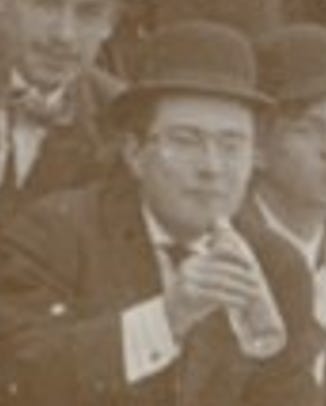
2. The Monson Family - young blonde-haired Blanche was, albeit unwittingly, a major help in putting together who this family was.9 At the time of the photograph Walter was serving as President of the London Conference and had his wife and children with him. In the 4th July photograph, some of their children are in front of them and others are further to the centre of the group.

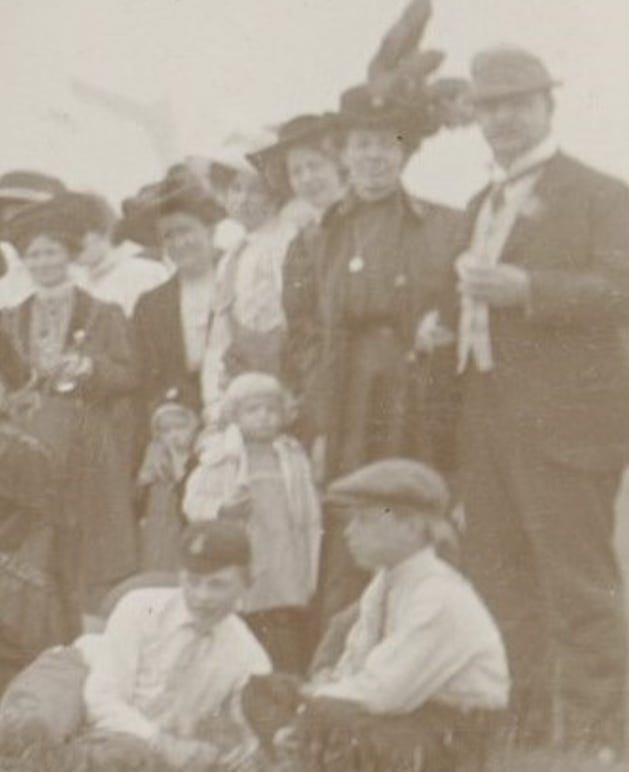
The Hunt Continues
Knowing that Lester Robbins had some kind of a connection to this outing and being able to match several of the other photo postcards to the ones of the Epping Forest outing suggests that at least some of those present were full-time Latter-day Saint missionaries. But would there be any kind of written account that could corroborate this discovery?
The Latter-day Saints’ Millennial Star is the longest-running publication in the history of The Church of Jesus Christ of Latter-day Saints and operated from 1840 through to 1970. However,
there was no account of the trip published in the Star, as it was often referred to. After finding a list of missionaries serving in the British Mission in 1910 I began searching through the Church History Library’s catalogue to determine whether there were any records from another missionary who had served there at the time.
That is when I stumbled across Ira Owen Horsfall’s papers. In 1908, he was called to serve as a missionary in the Turkish Mission. Due to political unrest, he was moved to England in 1909 when the mission was closed. Fortunately, Elder Horsfall wrote regularly to his loved ones back home. In a similar measure of good fortune, the family preserved the letters he sent. He notes that he was assigned to be the ‘Conference Clerk’, which would have involved maintaining membership and financial records, and other related tasks. Elder Horsfall also notes that there were approximately 45 missionaries serving in the London Conference at that time. Let’s read from his letter sent on 11 July 1910:
A week ago on July 4th all the elders assembled at Epping Forest, a natural Forest in North London and had a great ball game. The mighty players arrayed themselves up in true style and gave an exhibition of the great American game.10
There we have it. A group of American Latter-day Saint missionaries gathered in Epping Forest to celebrate their country’s Independence Day with some local members joining them. As with years previous, the Saints enjoyed sports, donkey rides, and presumably enjoyed a tasty lunch. As is visible in the hands of many missionaries there were drinks available in small glass bottles.
But what was in the bottles?
It is unlikely that the missionaries would have brought crates of bottled drinks to enjoy on the day. Previous accounts refer to missionaries cycling to the forest from different areas of London. So what was in the bottles and where did they come from?
Epping Forest was home to Butler’s Retreat, which was a Temperance movement establishment for people visiting the forest. The building had been destroyed by fire in January 1907 but it was soon functioning again.11 Non-alcoholic refreshments were served to the public. Food included meat pies, hot potatoes, and apple pies. Tea, coffee, bottles of pop including lemonade, dandelion and burdock, cola, cream soda, ginger beer, and other drinks, such as non-alcoholic lagers, were sold in Temperance establishments across the country, including Butler's Retreat.
We of course cannot know exactly what was in the bottles, but given the liquid appears clear and that we can assume the missionaries were observing their faith’s health code, then it was probably lemonade. While we were not there to watch them purchase the drinks, it stands to reason that they had visited Butler’s Retreat or a similar establishment to wet their whistle on that July afternoon.
‘Poor Children’s Outing,’ Walthamstow and Leyton Guardian, 9 September 1910, p. 6.
‘Abstract of Correspondence,’ The Latter-day Saints’ Millennial Star, Vol. 63, No. 32 (1901), p. 525; ‘Pleasant Excursions,’ The Latter-day Saints’ Millennial Star, Vol. 69, No. 33 (1907), pp. 526-527; ‘Healed by Faith,’ The Latter-day Saints’ Millennial Star, Vol. 69, No. 34 (1909), p. 542; and James Walter Paxman, missionary journal, 5 August 1885, p. 255, MSS 1036, L. Tom Perry Special Collections, Harold B. Lee Library, Brigham Young University, Utah, United States of America.
‘Pleasant Excursions,’ The Latter-day Saints’ Millennial Star, Vol. 69, No. 33 (1907), pp. 526-527.
‘Group of people at Epping Forest [1]’, in Lester J. Robbins photographs, circa 1908-1910, PH 1485, bx. 1, fd. 7, CHL.
‘Group of people at Epping Forest [2]’, in Lester J. Robbins photographs, circa 1908-1910, PH 1485, bx. 1, fd. 7, CHL.
‘Group of people at Epping Forest [3]’, in Lester J. Robbins photographs, circa 1908-1910, PH 1485, bx. 1, fd. 7, CHL.
‘Baptisms,’ The Latter-day Saints’ Millennial Star, Vol. 72, No. 3 (1910), p. 45; and ‘Baptisms,’ The Latter-day Saints’ Millennial Star, Vol. 72, No. 12 (1910), p. 189.
‘From the Mission Field,’ The Latter-day Saints’ Millennial Star, Vol. 72, No. 52 (1910), p. 830.
Walter P. Monson mission and family photographs, PH 3050, bx. 1, fd. 1, CHL; and ‘Group of people at Epping Forest [2]’, in Lester J. Robbins photographs, circa 1908-1910, PH 1485, bx. 1, fd. 7, CHL.
Letter from Ira Owen Horsfall to Nora Pendleton, 11 July 1910, MS 33353, bx. 1, fd. 3, CHL.
‘Butler’s Retreat Burnt,’ Woodford Times, 1 February 1907, p. 8.



